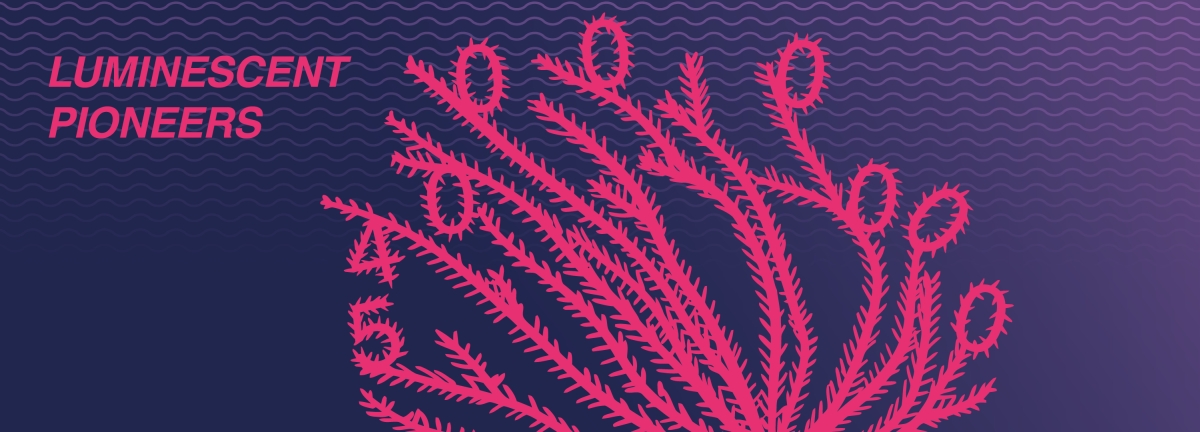
Shining pioneers
No electricity, no streetlights, just the gentle glow of living organisms: Is this what street lighting could look like in the future? Although it might sound like a scene from a science fiction film, it could well become reality – thanks to a principle that nature has perfected for millions of years, and one that fascinates humanity and researchers worldwide: Bioluminescence.
Nature as a light source
Bioluminescence describes the ability of living organisms to produce light in their own bodies through chemical reactions. The phenomenon exists in over 3500 different species worldwide: It’s encountered In meadows, forests and caves, but most commonly, in the depths of the oceans.
You’ve probably heard of examples such as glow-worms, fireflies, illuminated mushrooms in rainforests, “marine glow” in bays, and flashing deep-sea fish. At first glance, such manifestations in dazzling colours and unusual patterns might seem like nothing more than a captivating natural spectacle. From a more scientific perspective, though, it’s actually an extraordinary yet evolutionary survival strategy.
Bioluminescence was and remains a versatile survival tool
The ability to self-luminate as an organism has been helping living creatures to survive and reproduce for over 540 million years in a variety of ways. For instance, fireflies send light signals to entice potential partners. Deep-sea fish use bioluminescence as counter-illumination to hide from their enemies. Anglerfish attract their prey with a luminous organ. And dinoflagellates scare off their predators as green-blue sparkling algae carpets.
What began with the ancestors of the octocoral has been established and continued in many species to this day. Bioluminescence has developed independently hundreds of times in various living organisms over the course of evolution. This enormous adaptability and assertiveness shows that bioluminescent organisms have a clear evolutionary advantage.
A great opportunity: Bioluminescence as a reproducible process
And this is precisely where the chemical “magic” comes in. Although many bioluminescent organisms are not related to each other, they use similar chemical reactions and molecules to produce light. It’s a prime example of convergent evolution.
To date, researchers still know relatively little about luminous creatures. What is clear, however, is that most bioluminescence phenomena result from oxygenation reactions. The organism’s own phosphor molecules react with oxygen molecules and/or other chemical elements. Energy is then released in the form of light.
It can be described more precisely using the example of fireflies: Here, the enzyme luciferase produced in the bodies of fireflies causes the fluorescent molecule luciferin to react with oxygen molecules. During this process, the luciferins are enriched with oxygen. As the luciferin electrons are excited to a higher energy level by the energy of the body’s cells and then fall back to the original level, energy is released in the form of photons and heat. If this happens in frequent succession, this photon flow becomes visible as firefly light.
The high energy efficiency of fireflies and other insects is remarkable
A conventional light bulb only emits about 5% light and 95% heat, whereas an LED light emits 50% light and 50% heat. But the firefly, by contrast, emits around 95% light and only 5% heat. This level of energy conversion and performance holds immense potential, which humanity is increasingly taking advantage of.
Bioluminescence is highly efficient because the chemical energy is almost completely converted into light. Since the light reaction is fast and individual, even the smallest amounts of certain molecules, enzymes or toxins can be detected by bioluminescence. And since bioluminescence works in living organisms, physicians and researchers can observe these biological processes and changes in real time.
Current and visionary fields of application of bioluminescence
Inspired by nature, bioluminescence is already being used in medicine to make cancer cells or infections visible, for example. In environmental research, bioluminescent biosensors are helping to detect pollutants in water, air and soil, among other things. Even more visionary is the idea of using bioluminescent plants and microorganisms as natural, sustainable light sources.
Thanks to this, it’s not inconceivable that the streets of our future will be bathed in the gentle glow of living organisms.
In the interests of science, we are also working hard to expand our product range with a reliable and tailored range of options, in order to improve people’s lives. Find out more for yourself at: www.carlroth.com
Sources:
https://www.chemie.de/news/1183266/biolumineszenz-das-natuerliche-leuchten.html
https://nachrichten.idw-online.de/2024/04/18/biolumineszenz-das-natuerliche-leuchten
https://www.wissenschaft.de/erde-umwelt/biolumineszenz-seit-mindestens-540-millionen-jahren/
https://www.wissenschaft.de/erde-umwelt/gluehwuermchen-prinzip-bringt-krebszellen-den-tod/
https://chemistry-europe.onlinelibrary.wiley.com/doi/10.1002/cbic.202400106
https://www.planet-wissen.de/natur/forschung/phaenomen_licht/pwiebiolumineszenz100.html
https://www.nationalgeographic.de/wissenschaft/2019/12/wie-funktioniert-biolumineszenz-bei-tieren
https://www.scienceinschool.org/de/article/2016/living-light-chemistry-bioluminescence-de/

